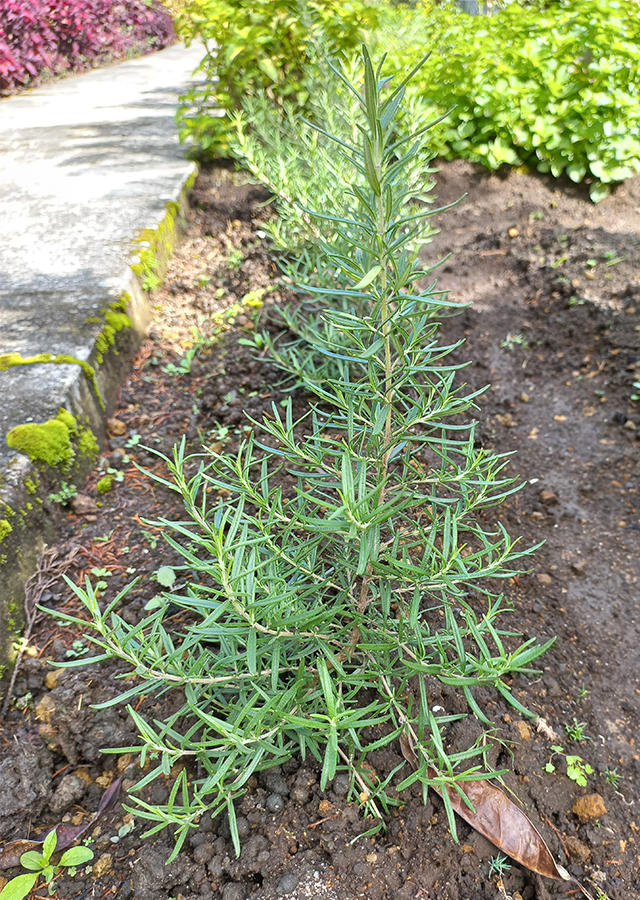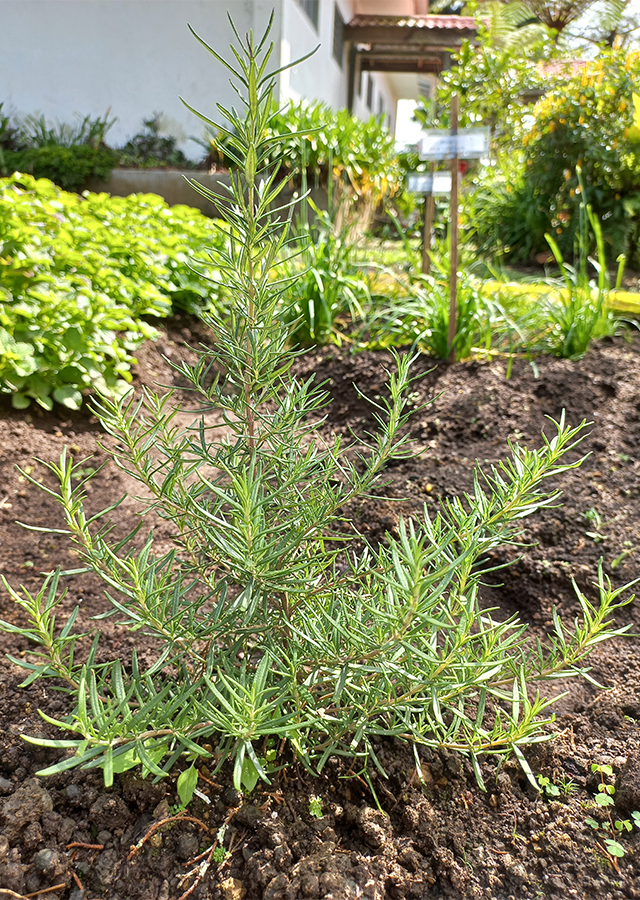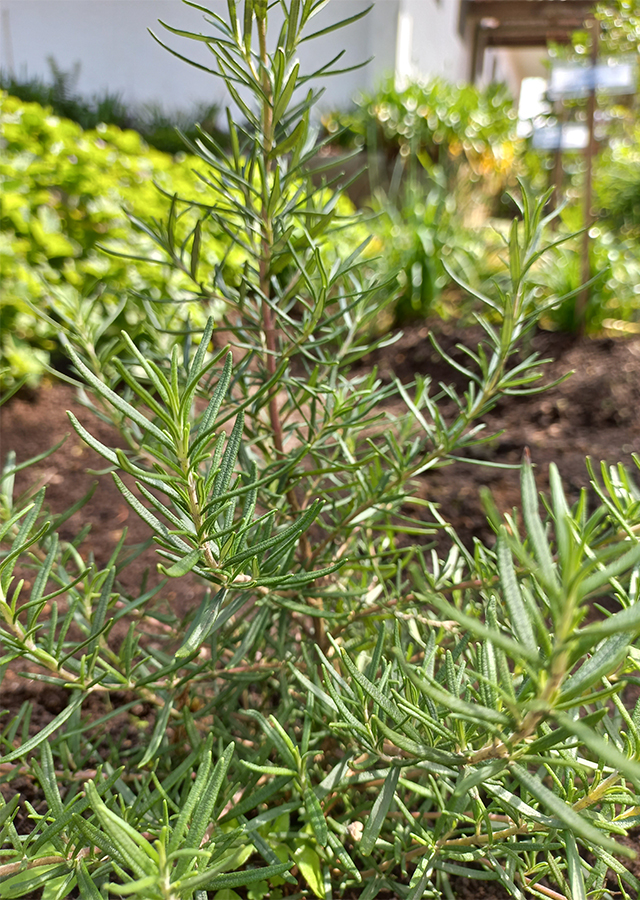Rosemary
Salvia rosmarinus Spenn.
Lamiaceae
Location in our garden
Principal



Synonym
Rosmarinus officinalis L.
Rosmarinus angustifolius Mill.
Rosmarinus communis Noronha
Habitus
Shrubs. An evergreen aromatic perennial shrub that grows 1.5 to 2 m tall
Part Used
Leaves
Twigs
Growing Requirements
Full Sunshine
Habitat
Shrublands
Terrestrial
Overview
Native to Mediterranean and Asia. The first mention of rosemary is found on cuneiform stone tablets as early as 5,000 BC. Rosemary is found in most English herbal texts, and is widely used for medicinal and culinary purposes. In 14th century, was one of the first alcohol-based perfumes in Europe, and was primarily made from distilled rosemary. It finally arrived in the Americas with early European settlers in the beginning of the 17th century. It soon was spread to South America and global distribution. Rosemary has therapeutic properties and has been used in the folk medicine, pharmaceutical, and cosmetics industries. It is also used as animal food, invertebrate food, has environmental uses and social uses and for food.The leaves are used to flavor various foods, such as stuffing and roast meats. Fresh or dried leaves are used in traditional Mediterranean cuisine. They have a bitter, astringent taste and a characteristic aroma which complements many cooked foods. Herbal tea can be made from the leaves.
Vernacular Names
Romarin (French), Rosmarin (German), Rozemarijn (Dutch), Rosmarino (Italian), Mi die xiang (Chinese), Lá hương thảo (Vietnamese), Roozumari (Japanese), Ro ju ma ri (Korean), Romero (Tagalog-Philippines).
Agroecology
Salvia rosmarinus found in terrestrial. It is considered easy to grow and pest-resistant. Rosemary is easily grown in pots. The groundcover cultivars spread widely, with a dense and durable texture. Rosemary grows on loam soil with good drainage in an open, sunny position. It will not withstand waterlogging and some varieties are susceptible to frost. It grows best in neutral to alkaline conditions (pH 7–7.8) with average fertility.
Morphology
- Root - fibrous system.
- Stems - herbaceous, while older stems become woody over time.
- Leaves - simple, entire margin, pinnate, stalkless to shortly-stalked, needle-like leaves are strongly aromatic, 1-2.5 cm long and 1-2 mm wide, green above, and white below, with dense, short, woolly hair. .
- Flowers - borne in the leaf axils along the upper parts of new stems. The flowers are whitish, bluish, or bluish purple flowers and are 2-lipped and tubular, the lower petal being three-lobed while the upper petal is two-lobed.
- Fruit - composed of 4 small, 1-seeded segments known as nutlets.
Cultivation
Vegetatively propagated by ground-layering - by fixing the stem to the ground until it forms roots and then, separating the rooted stem from the parent plant.
Chemical Constituents
Volatile oils (alpha-pinene, cineol, borneol, camphene, rosemarin), essential oils (pinene, camphor, 1,8-cineole, camphene, ß-pinene, bornylacetate, limonene, borneol, α-terpineol, cymene), terpenoids, monoterpenes, tannins, cardiac glycosides, flavonoids, saponins.
Traditional Medicinal Uses
- Rosemary has antifungal, antiviral, antibacterial, anti-inflammatory, antitumor, antithrombotic, antinociceptive, antidepressant, antiulcerogenic, and antioxidant activities.
- Bitter and astringent leaves considered diuretic, dissolvent, and aperient.
- Oil is carminative and stimulant.
- Studies have suggested antioxidant, antimicrobial, antinociceptive, antihyperglycemic, anti-obesity, radioprotective, anti-androgenic, antianxiety, antidermatophytic, hypolipidemic, renoprotective, anti-implantation, hepatoprotective, memory improvement properties.
- Steam of strong decoction of herb inhaled for coughs.
- Infusion of leaves as tea for dyspepsia, flatulence.
- Decoction of leaves as mouthwash for gums disease, halitosis, sore throat.
- Daily use of rosemary tea believed to prevent cataracts.
Part Used
Reference Sources
- Global Biodiversity Information Facility. (2021). Salvia rosmarinus Spenn.. https://www.gbif.org/species/113618606. 15-01-2022.
- Kew Royal Botanic Gardens. (2017). Plants of the World Online: Salvia rosmarinus Spenn.. http://powo.science.kew.org/taxon/urn:lsid:ipni.org:names:457138-1. 15-01-2022.
- de Macedo, L.M., et al. (2020). Rosemary (Rosmarinus officinalis L., syn Salvia rosmarinus Spenn.) and Its Topical Applications:A Review. Plants,9, 651; DOI:10.3390/plants9050651
- National Park of Singapore (2021). Flora Fauna Web: Salvia rosmarinus Schleid.. https://www.nparks.gov.sg/florafaunaweb/flora/3/3/3338. 15-01-2022.
- Stuartxchange. (2019). Romero-Rosmarinus officinalis. http://stuartxchange.com/Romero.html. 15-01-2022.

